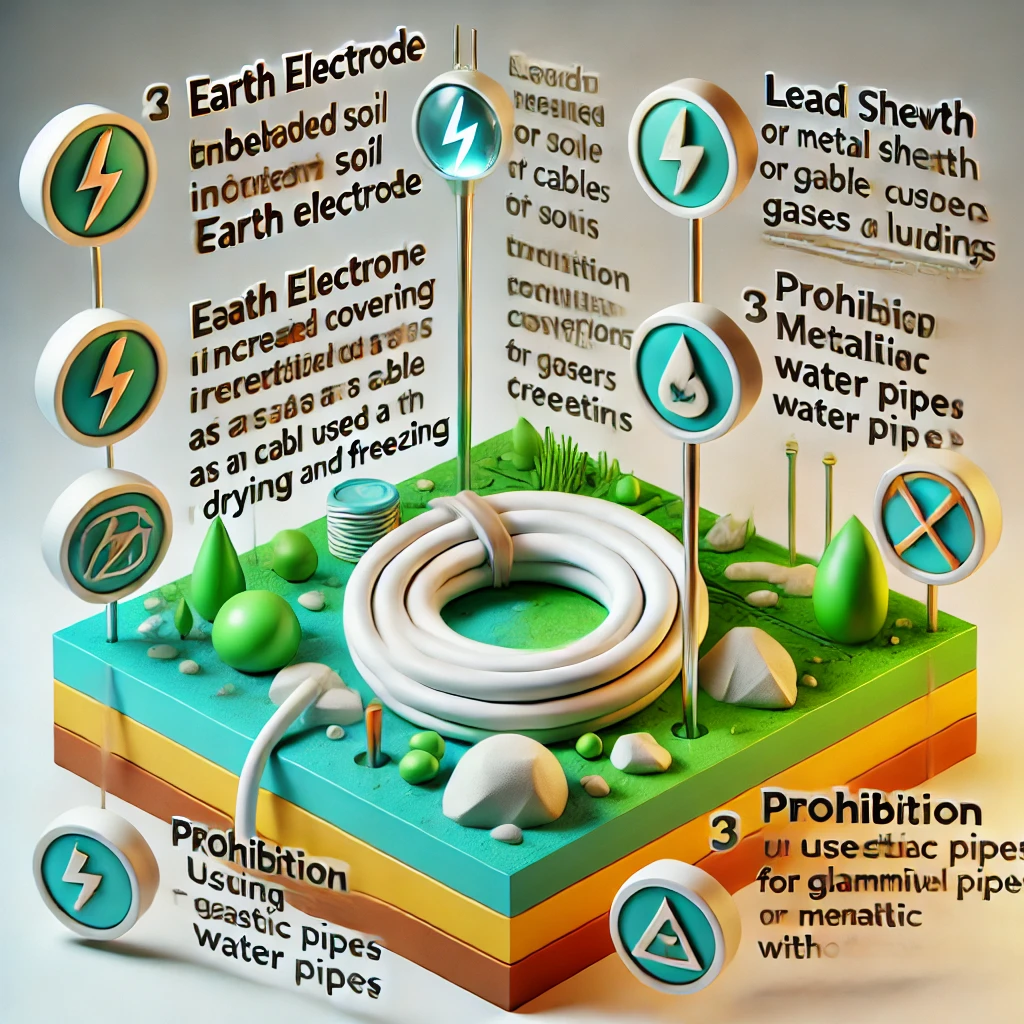The Importance of Proper Earth Electrode Installation
Regulation 542.2.4 states The type and embedded depth of an earth electrode shall be such that soil drying and freezing will not increase its resistance above the required value.

OW London Electrician and Home Automation Engineers Team
The Importance of Proper Earth Electrode Installation
Regulation 542.2.4 states:
"The type and embedded depth of an earth electrode shall be such that soil drying and freezing will not increase its resistance above the required value."
When installing an earth electrode, it's crucial to ensure that changes in soil conditions, such as drying out in summer or freezing in winter, do not negatively impact its effectiveness. Typically, this involves burying the electrode deep enough to reach soil that remains relatively stable throughout the year, often at least 600mm below the surface.

Frequently Asked Questions
What precautions must be taken when using the lead sheath or other metal covering of a cable as an earth electrode?
A: According to Regulation 542.2.5:
"The use, as an earth electrode, of the lead sheath or other metal covering of a cable shall be subject to all of the following conditions:
- Adequate precautions shall be taken to prevent excessive deterioration by corrosion;
- The sheath or covering shall be in effective contact with Earth;
- The consent of the owner of the cable shall be obtained;
- Arrangements shall exist for the owner of the electrical installation to be warned of any proposed change to the cable which might affect its suitability as an earth electrode."
When using a metal sheath as an earth electrode, it is crucial to ensure it remains in good condition over time. Corrosion can significantly reduce its effectiveness. Additionally, the metal sheath must make good contact with the Earth, which might not be the case if the cable has a polymeric oversheath. Finally, any changes to the cable that could affect its earthing capability must be communicated to the installation's owner to avoid future safety issues.
Can a metallic water pipe be used as an earth electrode?
A: According to Regulation 542.2.6:
"A metallic pipe for gases or flammable liquids shall not be used as an earth electrode. The metallic pipe of a water utility supply shall not be used as an earth electrode unless precautions are taken against its removal and it has been considered for such a use."
Using metallic pipes that carry gas or flammable liquids as earth electrodes poses significant safety risks. For water pipes, their use as an earth electrode is only permissible if there are safeguards to prevent their removal and if they are deemed suitable for this purpose. This regulation ensures that the earthing system remains intact and effective without posing risks related to the unintentional removal of the electrode.
What should be the characteristics of an earth electrode in terms of material and construction?
A: According to Regulation 542.2.7 and Regulation 542.2.8:
"An earth electrode shall not consist of a metal object immersed in water."
"Where an earth electrode consists of parts that must be connected together, connections shall be made by welding, pressure connectors, clamps or other suitable mechanical connectors."
An earth electrode must be durable and maintain good electrical continuity. Using metal objects immersed in water is unsuitable due to potential corrosion and variability in water conductivity. Mechanical connections should be robust, typically achieved through methods like welding or using pressure connectors, which ensure long-term reliability and effectiveness in maintaining the integrity of the earthing system.
What types of earth electrodes are recognized and recommended?
Various types of earth electrodes are recognized, including rods, plates, and mats. Rods are the most common and are driven into the ground. Plates and mats are used where soil conditions make rod driving difficult. The choice depends on soil resistivity and installation conditions. Rods should be separated by at least their driven depth to avoid overlapping resistance areas, ensuring effective earthing.
Explanation: The effectiveness of an earth electrode is highly dependent on its installation method and the surrounding soil conditions. In some instances, using multiple electrodes connected in parallel can reduce overall resistance significantly, provided they are adequately spaced apart.
How should the resistance of an earth electrode be tested?
The resistance of an earth electrode can be tested using methods like the fall of potential method. This involves measuring the voltage drop around the electrode using a series of test electrodes placed at specific distances from the main electrode. Modern testing equipment simplifies this process, ensuring accurate and reliable measurements.
Explanation: Regular testing and maintenance of earth electrodes are essential to ensure their effectiveness. The fall of potential method is a widely accepted technique that provides accurate resistance measurements, helping to verify the performance of the earthing system.
These FAQs address critical aspects of installing and maintaining earth electrodes as per BS 7671, providing clear guidance to ensure safety and compliance in electrical installations.
What users Saying
Discover what our customers think about our services. Their feedback reflects our commitment to delivering exceptional service and expert solutions for all electrical and security needs.

